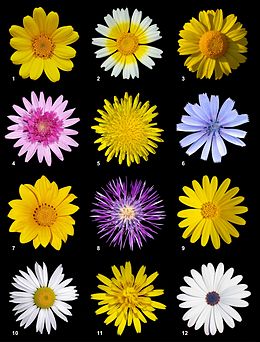Astérides
Astérides | ||
|---|---|---|
 | ||
| Clasificación científica | ||
| Reinu: | Plantae | |
| División: | Angiospermae | |
| Clas: |
Eudicotyledoneae (nuclear) Pentapetalae Superastéridas | |
| Subclas: |
Asteridae (Takht. 1964, Cronq. 1981) o Sympetalae (Juss. 1789, Rchb. 1828) | |
| Clados y órdenes[1] | ||
| ||
| Consultes | ||
| [editar datos en Wikidata] | ||
Les astéridas son un gran grupu d'eudicotiledóneas qu'inclúi aproximao 80 000 especies, arrexuntaes en 13 órdenes y más de cien families[2] y ente la tercera a la cuarta parte del total d'especies de les anxospermes.[3][4] Equival a les subclases tradicionales Asteridae y Sympetalae, y propúnxose como superorde Asteranae (Chase & Reveal 2009, Ruggiero et al 2015). Los estudios filoxenéticos denominar n'inglés asterids. Conjuntamente coles rósidas, constitúin los dos grupos más grandes de eudicotiledóneas. Representen el clado más apotípico (más estremáu del tipu orixinal, o como se diz indebidamente, «más evolucionáu») de les anxospermes. El grupu aniciar con toa probabilidá empecipiáu'l Cenozoicu, hai unos 50 millones d'años, y el so ésitu rellacionar cola coadaptación a insecto polinizadores.
Cuatro de les families más grandes de anxospermes pertenecen a esti clado: les asteráceas, les rubiáceas, les lamiáceas y les apocináceas.[5]
Descripción
[editar | editar la fonte]Les plantes pertenecientes a esti clado carauterizar por ser herbales, con flores hermafrodites, cigomorfas (de simetría billateral), polinizadas por inseutos, polos estambres dispuestos nun círculu y los pétalos de la corola xuníos ente sigo formando un tubu. El xinecéu ta formáu por dos carpelos soldaos. Les flores entámense de cutiu n'inflorescencies apertaes, como les espigues de les llabiaes y les plantagináceas o los capítulos (cabezuelas) de les Compuestes.
Evolución y filoxenia
[editar | editar la fonte]La edá del grupu troncal de les astéridas, esto ye, la edá de les astéridas y los sos parientes estinguíos pertenecientes al mesmu llinaxe, envaloróse en 128 millones d'años. Les cornales y ericales diverxeron pocu dempués y la edá na que se supón empecipiaron la so diverxencia les restantes astéridas ye de 100 millones d'años.[5] Magar otros autores envaloraron que tal diverxencia producióse más tarde, aproximao fai 80 a 89 millones d'años.[6]
Situación del clado astéridas
[editar | editar la fonte]Cladograma esquemáticu y resumíu según APG III:
| eudicotiledóneas |
| |||||||||||||||||||||||||||||||||||||||||||||
Composición del clado astéridas
[editar | editar la fonte]Cladograma esquemáticu y resumíu según APG III:
| astéridas |
| ||||||||||||||||||||||||||||||||||||||||||||||||||||||||||||||||||||||||
La subclase Asteridae
[editar | editar la fonte]En tolos sistemes de clasificación de anxospermes, les astéridas fueron reconocíes. Ello ye que les plantes coles coroles formando un tubu pola unión de los pétalos polos sos cantos, conocida como corola simpétala, fueron reconocíes como un grupu natural por Antoine-Laurent de Jussieu nel sieglu XVIII cuando publicó la so obra Genera plantarum, y al que denominó «Sympetala».[7] Armén Tajtadzhián renombró al grupu como subclase Asteridae en 1964, estremándolo nos superordes Lamianae y Asteranae, aproximao equivalentes a los actuales grupos lámidas y campanúlidas,[8][9] anque más tarde acutar a dellos órdenes solamente.[10] Arthur Cronquist caltuvo, sicasí, una circunscripción amplia de la subclase Asteridae na so sistema de clasificación, que incluyía a Asterales, Dipsacales, Gentianales, Lamiales y Solanales.[11]
Referencies
[editar | editar la fonte]- ↑ The Angiosperm Phylogeny Group III ("APG III", n'orde alfabéticu: Brigitta Bremer, Kåre Bremer, Mark W. Chase, Michael F. Fay, James L. Reveal, Douglas E. Soltis, Pamela S. Soltis y Peter F. Stevens, amás collaboraron Arne A. Anderberg, Michael J. Moore, Richard G. Olmstead, Paula J. Rudall, Kenneth J. Sytsma, David C. Tank, Kenneth Wurdack, Jenny Q.-Y. Xiang y Sue Zmarzty) (2009). «An update of the Angiosperm Phylogeny Group classification for the orders and families of flowering plants: APG III.». Botanical Journal of the Linnean Society (161): páxs. 105-121. Archivado del original el 2017-05-25. https://wayback.archive-it.org/all/20170525104318/http://onlinelibrary.wiley.com/doi/10.1111/j.1095-8339.2009.00996.x/abstract.
- ↑ Birgitta Bremer, Kare Bremer,Nahid Heidari,Per Erixon, Richard G. Olmstead, Arne A. Anderberg, Mari Kallersjo, and Edit Barkhordariana (10Mar2009), «Phylogenetics of asterids based on 3 coding and 3 non-coding chloroplast DNA markers and the utility of non-coding DNA at higher taxonomic levels», Molecular Phylogenetics and Evolution 106 (10): 3853–3858, http://www.bergianska.se/pub/publikationer/Bremer/Bremer_etal_6-xen_2002.pdf
- ↑ Robert W. Scotland and Alexandra H. Wortley, «How many species of seed plants are there?», Taxon 52 (1): 101–104, doi:
- ↑ Douglas E. Soltis, Pamela S. Soltis, Peter K. Endress, and Mark W. Chase, Phylogeny and Evolution of the Angiosperms, Sunderland, MA, USA: Sinauer, ISBN 978-0878938179
- ↑ 5,0 5,1 Stevens, P. F. (2001 d'equí p'arriba) Angiosperm Phylogeny Website Versión 9, Xunu 2008 y actualizáu dende entós. http://www.mobot.org/MOBOT/research/APweb/ Fecha d'accesu: 10 de mayu de 2010.
- ↑ Moore, M. M. [et al. 2010], Soltis, P. S., Bell, C. D., Burleigh, J. G., & Soltis, D. E. 2010. Phylogenetic analysis of 83 plastid genomes further resolves the early diversification of eudicots. Proc. National Acad. Sci. U.S.A. 107:4623-4628
- ↑ Jussieu, A.L., 1789. Genera Plantarum. Viduam Herissant, Paris.
- ↑ Takhtajan, A. (1964). The taxa of the higher plants above the rank of order. Taxon 13(5): 160-164, [1]
- ↑ Takhtajan, A., 1969. Flowering plants, origin and dispersal. Edinburgh, Oliver and Boyd.
- ↑ Takhtajan, A., 1997. Diversity and classification of flowering plants. Colombia University Press, New York.
- ↑ Cronquist, A., 1981. An integrated system of classification of flowering plants. Columbia University Press, New York.
Enllaces esternos
[editar | editar la fonte]| Wikispecies tien un artículu sobre Astérides. |
Text is available under the CC BY-SA 4.0 license; additional terms may apply.
Images, videos and audio are available under their respective licenses.
